Alderney Nature Diary
May 2001
The Weather
60% of the total rain for the month fell on 1st, with only 15-17th with any other significant falls. Last May had almost 4 times as much and the long term average is nearly double. Despite this, May was only the 12th driest since 1955, but the overall total for the first 5 months of the year is the highest since 1955.
Sunshine, with only one completely sunless day, was some 84 hours up on last year and 42 hours up on the long-term average. The last day of the month was the sunniest May day in our records. There were several foggy days towards the end of the month, with the island closed to air traffic until late afternoon on 26th, unfortunately coinciding with the Spring Bank Holiday weekend. The airport remained open late and most passengers got in that evening.
Wind speeds were about average overall, but with four unusually calm days on 11, 19, 29 and 30th, and several others with only light winds.
Humidity was high for the month, with only one day when the maximum was below 100% and only the last 3 days with the 24hr-average below 90%.
Temperatures were about normal, but with slightly warmer than average nights.
Figures for comparison with May last year and the 20-year average
| Year |
2001 |
2000 |
20-year average |
| |
|
|
1981-2000 |
| Rain mm. |
25.9 |
104.7 |
45.6 |
| Sun hrs. |
278.4 |
193.9 |
236.2 |
| Max. temp recorded °C |
19.6 |
22.2 |
19.4 |
| Min. temp recorded |
7.2 |
6.0 |
5.6 |
| Mean day temp |
13.6 |
13.4 |
14.4 |
| Mean night temp |
11.8 |
11.4 |
9.2 |
| Total rainfall, year to date, mm. |
481.0 |
300.1 |
276.8 |
| Total sunshine, year to date, hrs. |
278.4 |
193.9 |
236.2 |
The Diary
7th May. Blackbird feeding two well-grown young in the garden. Hundreds of Swallows 'hawking' over Longis pond and over several of the, still-flooded, areas. St. Mark's Flies (Bibio marci) about everywhere over Longis and Mannez areas, the males with their long dangling legs, flying slowly over the grassy areas looking for females in the grass below. These are the first I've seen this year and much later than usual, St Mark's Day, when they usually appear, being April 25th.
The garden is coming into flower with the yellow of Primroses and a few Sowthistles (Sonchus oleraceus), the blue of Brunnera macrophylla, a sort of overgrown Forget-me-not, White Campion (Silene latifolia) and the huge pinky-mauve, mushroom-shaped heads of the Maderan Geranium (Geranium maderense, picture on right), up to a metre across, with their thick stems supported by the sturdy, dropped, bright red, stalk
 s of the lower leaves, which bend downwards from their attachment points with their top ends on the ground, to form a ring of props supporting the considerable weight of the flower heads, making a grand show in many gardens. This seems to be a comparatively recent arrival in Alderney, but it seeds prolifically and is now to be seen in many gardens. The heads remain in flower for up to three months, opening many new 2.5cm blooms each day.
s of the lower leaves, which bend downwards from their attachment points with their top ends on the ground, to form a ring of props supporting the considerable weight of the flower heads, making a grand show in many gardens. This seems to be a comparatively recent arrival in Alderney, but it seeds prolifically and is now to be seen in many gardens. The heads remain in flower for up to three months, opening many new 2.5cm blooms each day.
10th May. After the first rain for 10 days the grass on the northern slopes of the Butes was soaking wet. There, the island's only colony of Alexanders (Smyrnium olusatrum), a very common plant in Guernsey, has spread considerably in the last two years and is now scattered over about a 50m area, its pale yellow-green leaves and yellow flower heads showing well. This is usually the earliest flowering of the Apiaceae family, formerly known more descriptively as the 'Umbelliferae' .In the same area Cut-leaved and Round-leaved Crane's-bills (Geranium dissectum & G. rotundifolium) were now in flower as well as the smaller and almost ubiquitous Dove's-foot Crane's-bill (G. molle). 'Lamb's-lettuce' more properly known as Cornsalads (Valerianella spp.) is flowering in many places, especially on walls and dried p
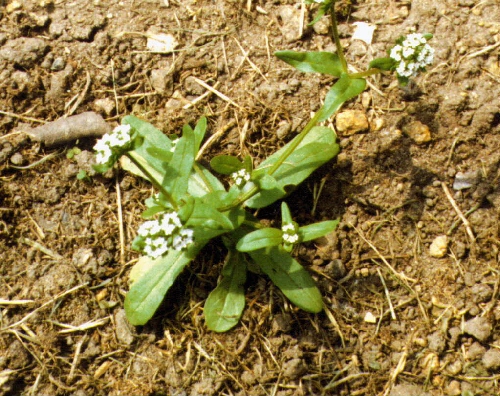 athways. It is also a common garden weed and has been used in the past as a salad vegetable, although to my taste it has little flavour. We have four different species of this genus, the 'Common Cornsalad' (V. locusta) seems actually to be the rarest here with 'Keeled-fruited Cornsalad' (V. carinata picture on left) the commonest. They are almost impossible to distinguish except by the charteristics of their seeds, and none were in fruit yet. The small plants, rarely more than 15-20cm tall with 1cm heads of inconspicuous pale blue/mauve flowers make a considerable contrast to the strong, coarse growth of their close relative, Red Valer
athways. It is also a common garden weed and has been used in the past as a salad vegetable, although to my taste it has little flavour. We have four different species of this genus, the 'Common Cornsalad' (V. locusta) seems actually to be the rarest here with 'Keeled-fruited Cornsalad' (V. carinata picture on left) the commonest. They are almost impossible to distinguish except by the charteristics of their seeds, and none were in fruit yet. The small plants, rarely more than 15-20cm tall with 1cm heads of inconspicuous pale blue/mauve flowers make a considerable contrast to the strong, coarse growth of their close relative, Red Valer
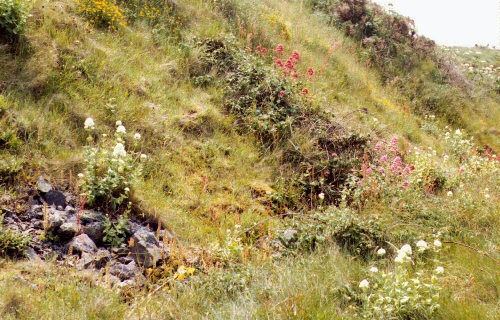 ian (Centranthus rubra picture on right), whose large flower heads in all shades between dark pink and pure white and thick, fleshy, pale green, stems and leaves, decorate walls, cliffs, quarry scree and many waste places all over the island. These too are just beginning to flower.
ian (Centranthus rubra picture on right), whose large flower heads in all shades between dark pink and pure white and thick, fleshy, pale green, stems and leaves, decorate walls, cliffs, quarry scree and many waste places all over the island. These too are just beginning to flower.
Slightly surprising here, in the long damp grass were many plants of Hare's-foot Clover (Trifolium arvense), which usually seems to prefer dry sandy soils, and many clumps of a sedge. Taking a specimen home to identify later, I was surprised to find that it seems to be either the Slender Tufted-sedge (Carex acuta) or the similar looking Common Sedge (C. nigra), neither of which appear in our previously recorded flora, and which also appear to be uncommon, or very rare, in the other islands. Unfortunately I did not realise this absence from out records until I came to write this diary, several weeks later, from my notes made on the spot. I have retained the specimen, pressed loosely into my field guide with others on the same page, but will now have to wait until next year to obtain further specimens in flower, to have identified by an expert.
Several Horse Chestnuts (Aesculus hippocastanum) were flowering at Essex Hill and in the Churchyard.
Wheatears were plentiful today on Platte Saline, their white rumps highly conspicuous when in flight, giving credence to the old name of "White Arse", from which this appears to be a corruption. The story goes that Queen Victoria once asked a countryman the name of this bird when she saw it and did not think his reply very "suitable", so it was renamed to prevent giving further offence to Her Majesty. They seem to have little to do with cornfields, flitting low over coarse grassland and heaths. Round-leaved Geranium and Lamb's Lettuce were also frequent here and in gutters along St. Martins, in town.
...................

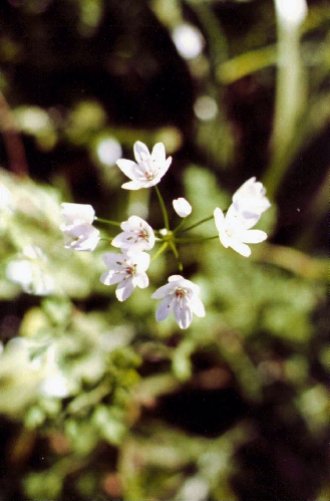
Taking a walk down Barrackmaster's Lane in the afternoon, I noted several plants of Star-of-Bethlehem, (Ornithogallum angustifolium photo on left above), Garlic Mustard (Alliaria petiolata) in some quantity, with Elder (Sambucus nigra), Apples (Malus spp.) and Honeysuckle (Lonicera periclymenum) all just coming into flower. There was another clump of about 20 Star-of-Bethlehem on a bank along the edge of the Golf course and two more plants about 200m away in their old spot on top of the roadside wall where I had not seen them for a couple of years. The similar appearing, but much more delicate, Hairy Onion (Allium hirsutum photo on right) was in flower near the Lighthouse, this year with about a dozen stems in flower.
13th May. A single Swift zoomed over my head on Longis Common. No Swallows around here today.
16th May. The Red Horse Chestnuts (Aesculus carnea) are now in flower in La Vallée and La Trigale, as is the Hawthorn (Crataegus monogyna), but the leaves on the Indian Chestnut (Aesculus indica), planted by the Queen in Connaught Square are not even breaking yet. It is always about a month later.
17th May. an hour spent botanising in Mannez quarry found a wealth of our 'special' clover family plants in flower as well as many more common species. The pink and white Bird's-foot and Yellow Bird's-foot (Ornithopus perpusillus & O. pinnatus) in quantity over large areas of short turf, with all three yellow Trefoils, Hop, Lesser and Slender (Trifolium campestre, T. dubium & T. micranthum), were also plentiful. The small, even minute white flowers of Western, Suffocated and Bird's-foot Clovers (T. occidentale, T. suffocatum & T. ornithopodiodes) formed large patches and the robust Red Clover (T. pratense), and large brilliant yellow areas of Gorse (Ulex europaeus), completed the tally of this family. Amongst the drier areas of short turf Annual, Common and Heath Pearlworts (Sagina apetala subsp. apetala, and subsp. erecta, and S. subulata) were frequent.
In the pond itself and round the edges, Yellow Flag (Iris pseudacorus), Parrot's-feathers and Spiked Water-milfoil (Myriophyllum aquaticum & M. spicatum) were in some quantity, as was the invasive but minute flowered New Zealand Pigmy-weed (Crassula helmsii), Lesser Bulrush (Typha angustifolia), large patches of Soft Rush (Juncus effusus), and Water Mint (Mentha aquatica). There seemed to be no sign of the usual area of Three-leaved Water-Crowfoot (Ranunculus trichophyllus) this year.
18th May. The single plant of Wild Strawberry I found 3-4 years ago growing from a crevice in the N wall of the Churchyard is still there It had a few flowers and some runners, but these did not seem to have taken root between the stones and spread the plant since I last saw it. In the public gardens of The
 Terrace, fortunately somewhat neglected so far this year, large areas of the Italian Lords-and-Ladies (Arum italicum subsp. italicum with white-veined leaves and subsp. neglectum with plain green leaves), were in flower, their large creamy-white spathes and yellow spadix showing well. The single purple-spotted-leaved plant in these gardens, which may be a hybrid with A. maculatum, (a plant never yet recorded in Alderney, except for a probable error in recording in 1954), photo on left, is also surviving but has not spread. A few days later I managed, for the first time over several years, to find it flowering. The spathe was much smaller than the others, but still creamy white and the spadix was bright yellow, not purple. Maybe it is just a 'sport' of the normal Italian form.
Terrace, fortunately somewhat neglected so far this year, large areas of the Italian Lords-and-Ladies (Arum italicum subsp. italicum with white-veined leaves and subsp. neglectum with plain green leaves), were in flower, their large creamy-white spathes and yellow spadix showing well. The single purple-spotted-leaved plant in these gardens, which may be a hybrid with A. maculatum, (a plant never yet recorded in Alderney, except for a probable error in recording in 1954), photo on left, is also surviving but has not spread. A few days later I managed, for the first time over several years, to find it flowering. The spathe was much smaller than the others, but still creamy white and the spadix was bright yellow, not purple. Maybe it is just a 'sport' of the normal Italian form.
The graceful Cow Parsley was there in profusion as well. The Holly (Ilex aquifolium) trees planted amongst the Sycamores (Acer platanoides) to replace the few that were dying, which have now been felled, have thrived and are double the size they were 2-3 years ago. A number of quite sizeable Elms (probably Ulmus minor subsp. sarniensis) have developed from suckers of the original 150+ year-old avenue which was felled about 10 years ago, long after they had died of the Dutch Elm disease. One or two of them, just over the wall in the Valley Gardens are as much as 30cms in diameter now, and appear healthy. A few new trees have been planted including a weeping green beech, doing very well, a Copper Beech and a couple of (not very suitable) Blue Gums (Eucalyptus spp.). Despite the mass of Ivy ground cover here, there is no sign of any Ivy Broomrape (Orobanche hederae).
Whilst abundant in Guernsey, this parasitic plant is strangely rare in Alderney, being as far as I know, confined to the single valley along the line of the stream which starts from springs under the Grand Blaye, used to emerge at the former public washplace near the bottom of Little Street, supply the former public pump in Marais Square, run across what is now Royal Connaught Square at, what was then, the bottom of the old Vicarage Garden and down to La Vallée, then to Platte Saline and the sea. This stream has been largely underground since the 18th and early 19th century developments around Marais and Connaught Squares, passes under the Island Hall, whose basement it still floods occasionally, and emerges as strongly flowing springs just below the Terrace Gardens. There is some considerable quantity of the Broomrape in the Vicarage front garden in Connaught Square, on the roadside banks of the house called Les Sources, next to the Terrace gate, from where the water runs downhill in an open streambed, more just across the road in the Sycamore wood above the top of the tall wall, and at the bottom of the hill by the junction with Butes Lane. By pure coincidence, yesterday (16th June) I found a colony amongst the Ivy just below the old wall in the recently formed car park of the newly extended Le Cocq's Store, just off Marais Square and almost exactly in the probable line of the underground watercourse. The very name of the square means 'marsh' and the nearby tiny street called Mare Jean Bot, locally pronounced 'marge-e-bo' emphasises the fact that, before the area was drained and paved with cobbles in the early 1800s, there was plenty of damp ground here from the stream and springs.
The bank between the fort walls and the road a mass of Pink Campion (Silene x hampeana) and plenty of Milkwort (Polygala vulgaris) over several yards of the verge on the first S-bend in Tourgis Hill, the flowers here quite a dark mauve colour. Later in the day I found several large clumps of it along the east coast with much paler, almost white flowers. On Platte Saline just below the fort, Hare's-tail Grass (Lagurus ovatus) has formed wide expanses of mainly dwarfed plants in the compacted quarry waste which was tipped into the old sand pit a few years ago, and also a number of patches of Great Quaking-grass (Briza major). Both are pretty and striking-looking annual grasses, producing plentiful seed, and have spread considerably over the last five years. A few plants of Wild Clary (Salvia verbenaca) and a quantity of Common Broomrape (Orobanche minor) were flowering in the short turf close to the sea. Sea Kale has spread considerably along the beach and in the dunes here over the last few years and there were masses of the Sandhill Snail (Theba pissana), a Mediterranean mollusc which reached the Channel Islands in the 1930's, on their leaves. The pond is still well filled after the heavy rains of the winter and spring and several groups of Mallard have bred here. One duck had nine newly hatched babies swimming with her and another 13, a bit larger. The Crows were flying around trying to take them, but they were to some extent protected by the vegetation growing in the water. A few Emperor Dragonflies (Anax imperator) were flying over the surface of the pond and clumps of Yellow Flag are blooming round the edges. The Galingale (Cyperus longus) has also spread considerably and one clump of Umbrella Sedge (Cyperus longifolius) a close relative of the Papyrus, has survived several winters and some very dry summers, at one side of the pond
19th May. Alongside the road across Longis common and on the east coast, more Wild Clary, the inflorescence of a Pyramidal Orchid (Anacamptis pyramidalis) first of the season, a poor specimen, an inch or so far enough from the road to escape the blades of the verge mower was just colouring up. The delicate 5-7cm high plants of Sand Cat's-tail were plentiful with the stiff spikes of Crested Dog's-tail (Cynosurus cristatus) also frequent on the well trodden paths. Many other grasses were also flowering by now, including quantities of the tiny Bromes (Bromus spp.) also only about 5-7cm high. A few tiny red plants, mostly about 2cm high, of Three-fingered Saxifrage (Saxifrage tridactylites) could be seen in the short grass alongside the tracks, with Thyme-leaved Sandwort (Arenaria serpyllifolia), no larger and the early growth from the perennial rootstocks of Bastard Toadflax (Thesium humifusum) just lengthening.
20th May. Two large-flowered Crane's-bills (what a lot of hyphenated names there are this
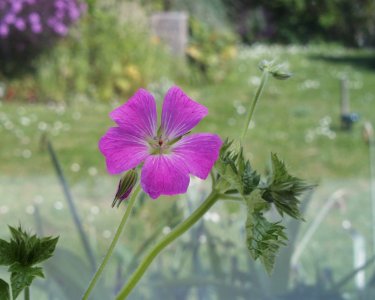 month !!!) found. One a dark pink, (photo on left),
month !!!) found. One a dark pink, (photo on left),
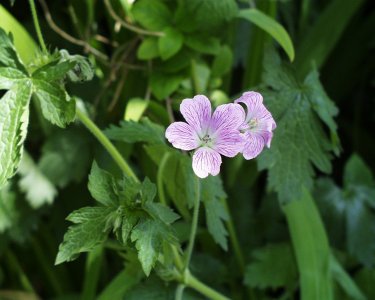 several plants about 80cm high in long grass on a bend in the road in Valongis, and the other, two plants nearly as tall with paler mauve striped petals in a similar verge in Val Fontaine. The latter may well be the Pencilled Geranium (Geranium versicolor) although this is rare in Alderney and I have never seen such large specimens (photo on right), but I shall have to send specimens of both to the BSBI Geranium referee to confirm them. Western and Red Clovers are still flowering in quantity, but no sign of White Clover (Trifolium repens) flowering yet.
several plants about 80cm high in long grass on a bend in the road in Valongis, and the other, two plants nearly as tall with paler mauve striped petals in a similar verge in Val Fontaine. The latter may well be the Pencilled Geranium (Geranium versicolor) although this is rare in Alderney and I have never seen such large specimens (photo on right), but I shall have to send specimens of both to the BSBI Geranium referee to confirm them. Western and Red Clovers are still flowering in quantity, but no sign of White Clover (Trifolium repens) flowering yet.
21st May. Three members of the British Lichen Society are in the island for a week updating the 1975 survey of Alderney Lichens. Peter James of the British Museum of Natural History, is one of the co-authors of The Lichen Flora of Great Britain and Ireland (Purvis et al 1992). Ann Allen wrote, and Barbara Hilton illustrated, their 1993, privately published, Field Companion; Flowers of Sark, and all three collaborated in the article Lichens of Sark published in the 1999 Transactions of La Société Guernesiaise. I spent an interesting day with them surveying the Lichens in the Churchyard, during which they recorded 60+ species, including several species not previously reported from Alderney. Lichens are not always easy to identify positively, and a deal of work is entailed with microscope and with chemical tests, which can only be done in the laboratory, on some species. Their whole visit has added a considerable number of new species to our list and I await their final report with great interest.
Whilst in the Churchyard I noted that the colony of Kraus's Clubmoss (Selaginella kraussiana) along the base of the NW wall of the Church has spread considerably in the last two years and now covers much of the 10 x 1m area of soil here. I hope that the more intrusive Mind-your-own-business (Soleirolia soleirolii) which grows at the upper, damper end of this shady spot does not eliminate it in due course. Once again this year I can see no sign of any flowers or developing fruit on the two large Hornbeam (Carpinus betulus) trees in the lower churchyard. I can find no evidence of the species being monoecious and therefore possibly the male trees, so wonder why this should be.
23rd May. Another visit to t
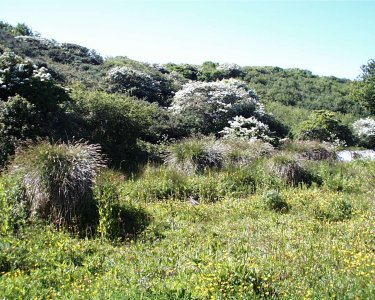 he old Watermill leat in Bonne Terre (photo on right), to see if the clearance work done by the Alderney Society has allowed the Southern Marsh Orchids (Dactylorrhiza praetermissa) to reappear. A list of around 30 species in flower, excluding grasses was made and, in addition to the 20+ huge stools of the Greater Tussock-sedge (Carex paniculata) (photo on left), recorded last year immediately after the scrub had been cleared, contained many of the usual damp, shady and streamside plants, i
he old Watermill leat in Bonne Terre (photo on right), to see if the clearance work done by the Alderney Society has allowed the Southern Marsh Orchids (Dactylorrhiza praetermissa) to reappear. A list of around 30 species in flower, excluding grasses was made and, in addition to the 20+ huge stools of the Greater Tussock-sedge (Carex paniculata) (photo on left), recorded last year immediately after the scrub had been cleared, contained many of the usual damp, shady and streamside plants, i
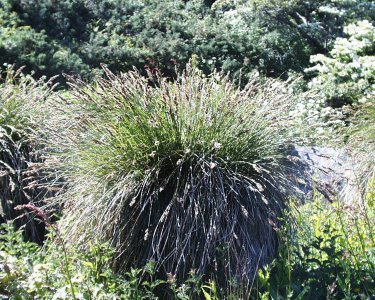 ncluding Ragged Robin (Lychnis flos-cuculi), Creeping Forget-me-not (Myosotis secunda), Water Figwort (Scrophularia auriculata), Common Fleabane (Pulicaria dysenterica), some huge specimens almost 2m high of Prickly Sow-thistle (Sonchus asper), Hedge Woundwort (Stachys sylvatica), Fools Water-cress (Apium nodiflorum), three species of Dock, Marsh and Creeping Thistles (Cirsium palustre & C. arvense), Shaggy Mouse-ear-hawkweed (Pilosella peleteriana), and several Ferns. There was no sign of the orchids h
ncluding Ragged Robin (Lychnis flos-cuculi), Creeping Forget-me-not (Myosotis secunda), Water Figwort (Scrophularia auriculata), Common Fleabane (Pulicaria dysenterica), some huge specimens almost 2m high of Prickly Sow-thistle (Sonchus asper), Hedge Woundwort (Stachys sylvatica), Fools Water-cress (Apium nodiflorum), three species of Dock, Marsh and Creeping Thistles (Cirsium palustre & C. arvense), Shaggy Mouse-ear-hawkweed (Pilosella peleteriana), and several Ferns. There was no sign of the orchids h
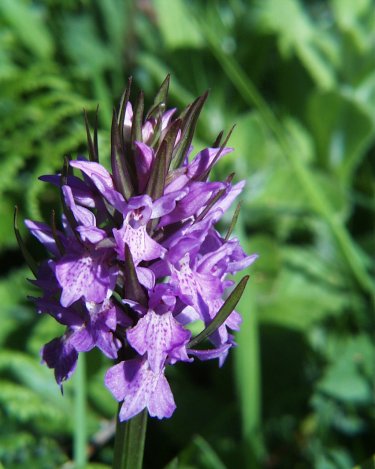 ere in their former spot, BUT, a few days later our young Conservation Officer, Roland Gauvain, spotted a single specimen, (photo on right), about 20m below the old dam wall under the edge of a group of Willows in the damp meadow beside the stream.
ere in their former spot, BUT, a few days later our young Conservation Officer, Roland Gauvain, spotted a single specimen, (photo on right), about 20m below the old dam wall under the edge of a group of Willows in the damp meadow beside the stream.
Further down this meadow the colony of Galingale is just sprouting its new growth and is about 60cm high. Beside the stone slab bridging the stream by the pumping station wall, a nice large clump of Slender Club-rush (Isolepis cernua), {with the terminal bristle barely longer than the inflorescence} had established itself, with several patches of Herb Robert (Geum urbanum), and Hedge Woundwort nearby. The, originally planted, hedge of Japanese Knotweed (Fallopia japonica) opposite, known in Guernsey as 'Donkey's Rhubarb', had been severely cut back to help prevent it spreading further across the path. This invasive garden introduction is now present in three or four places 'in the wild'. A patch in the dunes behind Braye Bay, a very small patch in The Terrace, spreading under the wall, from a much larger clump in the Valley Gardens, and very small clumps in two other spots.
In 1933 a Mauvaises Herbes Loi (Noxious Weeds Law) was introduced to prevent; Hogweed, thistles, docks, nettles, Ragwort and Hemlock Water-dropwort, (which last, a plant, highly poisonous to cattle, had actually been eradicated from Alderney by about 1868 some 66 years earlier !!!};), found growing on land whose owners were not good husbandmen, from infesting that of their neighbours. This made it an offence for the specified weeds to be allowed on the land in flower or seed. Charlock, Dandelions, Hedge Mustard and Three-cornered Leek were added to this list in 1952. The law was rarely, if ever, enforced in the last fifteen years or more.
With an astonishing lack of speed, in the revision of our Mauvaises Herbes Loi, which was being considered by the States in 1998/9; who, having cheerfully accepted the presence of Hemlock Water Dropwort (Oenanthe crocata), in this law, for a further 68 years since it was passed in 1933, had decided to retain this on the list of plants required to be eliminated when in flower or seed from the owner's land, "in case it should return". The 1933 law was copied from Guernsey's similarly named 1927 law, where this plant is quite common in wet places. When our law was amended in 1952, it then included the Three-cornered Leek, Allium Triquetum) (a pretty but highly invasive plant known in the CIs as 'Stinking Onions'). This is a Mediterranean plant first recorded in Alderney by Marquand in 1901 as; 'a patch about 5 yards square under the walls of Fort Tourgis and nowhere else...". By 1952 it had become widespread both in the wild and in gardens and today there is scarcely a verge, hedgebank, garden, or patch of waste ground, where large areas of it's heads of white flowers are to be seen from February, or earlier some years, to the end of April. The leaves appear in the Autumn and the back of each petal bears a green stripe down the midrib, Spreading by seeds, bulbils and division of the bulb, it is exceedingly difficult to eliminate and a strong smell of onions pervades the island on warm days where it has been touched or brushed against. It is not killed by many weed-killers. It's only merit is that the small white bulbs can be used in cooking as a substitute for garlic. Many visitors think it is a white Bluebell until they touch the leaves and smell onions.
The States also included in their proposed amendment the Japanese Knotweed (Fallopia japonica), a not very common garden introduction, which is, in the main, only a problem to those who have planted it and then find it impossible to eliminate from lawns, flower beds and hedges. They had, at the same time, removed from the list, Hogweed (Heracleum sphondyllium), referred to in the 1933 law as Cow Parsnip, very highly invasive, coarse, ugly, extremely widespread and, to many people, a potentially photosensitive skin irritant. This action seems to have been taken largely on the premise that the worst infestations of Hogweed are on States, i.e. public, land and the States cannot expect to enforce its removal by other landowners, without doing so themselves. The long awaited final outcome of this revision was to amend the 1933 law on 19th November 2003 and remove ALL of the 'Noxious weeds' from the list except for Ragwort, (Senecio jacobea), a plant normally avoided by grazing cattle and horses, but sufficiently toxic to kill the young animals if eaten in dried hay and to make older beasts severely ill.
In the field between the former mill reservoir, (just behind and above the mill wheel), and the stream, amongst many other plants, Hedge Mustard (Sisymbrium officinale), is flourishing and, just across the stream, the single plant of House Holly-fern (Phanerophlebia falcata), first recorded here in 1976, has now spread to a patch several metres in extent, with at least a dozen individual plants.
27th May. Large numbers of butterflies now being seen, particularly the Common Blue ( N), Wall ( ), and Speckled Wood ( ), with smaller numbers of Whites ( ), Red Admirals ( ) and others. Hairy rock-cress (Arabis hirsuta) was noted in the verge near La Cachette near the single Pyramidal Orchid recorded above.
29th May. A walk round and across Platte Saline allowed me to record 97 plants in flower in a little over half an hour. Several Emperor Dragonflies were patrolling over the pond and another Mallard duck was being closely followed in and out of the emergent vegetation by 13 ducklings. Two of them getting separated from the crowd, out of sight on the other side of some taller vegetation, received urgent quacks from the mother to guide them back to safety.
There were many different grass species present, amongst the more interesting and tinier ones, Sand Cat's-tail, Least and Lesser Soft-brome (Bromus hordeaceus subsp. feronii & B. x pseudothominei), Silver Hair-grass (Aira caryophyllea) and Sea Fern-grass (Catapodium marinum). None of them were more than about 5-6cm high. As well as the common Red and White Clovers, a good range of the small clovers were present. Western, Rough and Knotted Clovers (Trifolium occidentale, T. scabrum & T. striatum), Hop, Lesser and Slender Trefoils (T. campestre, t. dubium & T. micranthum). A few plants of Clary, quite a lot of Common Broomrape, a single plant of Goat's-beard (Tragapogon pratensis), two plants of Rosy Garlic (Allium roseum), one of Fragrant Evening Primrose (Oenothera stricta), Common Mallow (Malva sylvestris) was frequent, with Tree Mallow (Lavatera arborea), less so. Both yellow- and white-flowered forms of Sea Radish and considerable quantities of Hoary Mustard (Hirschfeldia incana), one of our common sandy area plants, rarely found in the UK. A single bush of Tree Lupin (Lupinus arboreus), and all of the plants already mentioned in this location were thriving. Just as well I checked them then, for the whole common was mown closely again a few days later.
31st May. The month finished with a visit to Mannez Quarry, where most of the rarer small plants recorded earlier in the month had now finished flowering, but I was rewarded with finding Heath Woodrush (Luzula multiflora), seemingly not a very common plant in the island, and Brown Sedge (Carex disticha), first noted here as recently as 1996 although it had almost certainly been present for many years before and misrecorded for a similar looking species.
 s of the lower leaves, which bend downwards from their attachment points with their top ends on the ground, to form a ring of props supporting the considerable weight of the flower heads, making a grand show in many gardens. This seems to be a comparatively recent arrival in Alderney, but it seeds prolifically and is now to be seen in many gardens. The heads remain in flower for up to three months, opening many new 2.5cm blooms each day.
s of the lower leaves, which bend downwards from their attachment points with their top ends on the ground, to form a ring of props supporting the considerable weight of the flower heads, making a grand show in many gardens. This seems to be a comparatively recent arrival in Alderney, but it seeds prolifically and is now to be seen in many gardens. The heads remain in flower for up to three months, opening many new 2.5cm blooms each day.
 athways. It is also a common garden weed and has been used in the past as a salad vegetable, although to my taste it has little flavour. We have four different species of this genus, the 'Common Cornsalad' (V. locusta) seems actually to be the rarest here with 'Keeled-fruited Cornsalad' (V. carinata picture on left) the commonest. They are almost impossible to distinguish except by the charteristics of their seeds, and none were in fruit yet. The small plants, rarely more than 15-20cm tall with 1cm heads of inconspicuous pale blue/mauve flowers make a considerable contrast to the strong, coarse growth of their close relative, Red Valer
athways. It is also a common garden weed and has been used in the past as a salad vegetable, although to my taste it has little flavour. We have four different species of this genus, the 'Common Cornsalad' (V. locusta) seems actually to be the rarest here with 'Keeled-fruited Cornsalad' (V. carinata picture on left) the commonest. They are almost impossible to distinguish except by the charteristics of their seeds, and none were in fruit yet. The small plants, rarely more than 15-20cm tall with 1cm heads of inconspicuous pale blue/mauve flowers make a considerable contrast to the strong, coarse growth of their close relative, Red Valer
 ian (Centranthus rubra picture on right), whose large flower heads in all shades between dark pink and pure white and thick, fleshy, pale green, stems and leaves, decorate walls, cliffs, quarry scree and many waste places all over the island. These too are just beginning to flower.
ian (Centranthus rubra picture on right), whose large flower heads in all shades between dark pink and pure white and thick, fleshy, pale green, stems and leaves, decorate walls, cliffs, quarry scree and many waste places all over the island. These too are just beginning to flower.


 Terrace, fortunately somewhat neglected so far this year, large areas of the Italian Lords-and-Ladies (Arum italicum subsp. italicum with white-veined leaves and subsp. neglectum with plain green leaves), were in flower, their large creamy-white spathes and yellow spadix showing well. The single purple-spotted-leaved plant in these gardens, which may be a hybrid with A. maculatum, (a plant never yet recorded in Alderney, except for a probable error in recording in 1954), photo on left, is also surviving but has not spread. A few days later I managed, for the first time over several years, to find it flowering. The spathe was much smaller than the others, but still creamy white and the spadix was bright yellow, not purple. Maybe it is just a 'sport' of the normal Italian form.
Terrace, fortunately somewhat neglected so far this year, large areas of the Italian Lords-and-Ladies (Arum italicum subsp. italicum with white-veined leaves and subsp. neglectum with plain green leaves), were in flower, their large creamy-white spathes and yellow spadix showing well. The single purple-spotted-leaved plant in these gardens, which may be a hybrid with A. maculatum, (a plant never yet recorded in Alderney, except for a probable error in recording in 1954), photo on left, is also surviving but has not spread. A few days later I managed, for the first time over several years, to find it flowering. The spathe was much smaller than the others, but still creamy white and the spadix was bright yellow, not purple. Maybe it is just a 'sport' of the normal Italian form.
 month !!!) found. One a dark pink, (photo on left),
month !!!) found. One a dark pink, (photo on left),
 several plants about 80cm high in long grass on a bend in the road in Valongis, and the other, two plants nearly as tall with paler mauve striped petals in a similar verge in Val Fontaine. The latter may well be the Pencilled Geranium (Geranium versicolor) although this is rare in Alderney and I have never seen such large specimens (photo on right), but I shall have to send specimens of both to the BSBI Geranium referee to confirm them. Western and Red Clovers are still flowering in quantity, but no sign of White Clover (Trifolium repens) flowering yet.
several plants about 80cm high in long grass on a bend in the road in Valongis, and the other, two plants nearly as tall with paler mauve striped petals in a similar verge in Val Fontaine. The latter may well be the Pencilled Geranium (Geranium versicolor) although this is rare in Alderney and I have never seen such large specimens (photo on right), but I shall have to send specimens of both to the BSBI Geranium referee to confirm them. Western and Red Clovers are still flowering in quantity, but no sign of White Clover (Trifolium repens) flowering yet.
 he old Watermill leat in Bonne Terre (photo on right), to see if the clearance work done by the Alderney Society has allowed the Southern Marsh Orchids (Dactylorrhiza praetermissa) to reappear. A list of around 30 species in flower, excluding grasses was made and, in addition to the 20+ huge stools of the Greater Tussock-sedge (Carex paniculata) (photo on left), recorded last year immediately after the scrub had been cleared, contained many of the usual damp, shady and streamside plants, i
he old Watermill leat in Bonne Terre (photo on right), to see if the clearance work done by the Alderney Society has allowed the Southern Marsh Orchids (Dactylorrhiza praetermissa) to reappear. A list of around 30 species in flower, excluding grasses was made and, in addition to the 20+ huge stools of the Greater Tussock-sedge (Carex paniculata) (photo on left), recorded last year immediately after the scrub had been cleared, contained many of the usual damp, shady and streamside plants, i
 ncluding Ragged Robin (Lychnis flos-cuculi), Creeping Forget-me-not (Myosotis secunda), Water Figwort (Scrophularia auriculata), Common Fleabane (Pulicaria dysenterica), some huge specimens almost 2m high of Prickly Sow-thistle (Sonchus asper), Hedge Woundwort (Stachys sylvatica), Fools Water-cress (Apium nodiflorum), three species of Dock, Marsh and Creeping Thistles (Cirsium palustre & C. arvense), Shaggy Mouse-ear-hawkweed (Pilosella peleteriana), and several Ferns. There was no sign of the orchids h
ncluding Ragged Robin (Lychnis flos-cuculi), Creeping Forget-me-not (Myosotis secunda), Water Figwort (Scrophularia auriculata), Common Fleabane (Pulicaria dysenterica), some huge specimens almost 2m high of Prickly Sow-thistle (Sonchus asper), Hedge Woundwort (Stachys sylvatica), Fools Water-cress (Apium nodiflorum), three species of Dock, Marsh and Creeping Thistles (Cirsium palustre & C. arvense), Shaggy Mouse-ear-hawkweed (Pilosella peleteriana), and several Ferns. There was no sign of the orchids h
 ere in their former spot, BUT, a few days later our young Conservation Officer, Roland Gauvain, spotted a single specimen, (photo on right), about 20m below the old dam wall under the edge of a group of Willows in the damp meadow beside the stream.
ere in their former spot, BUT, a few days later our young Conservation Officer, Roland Gauvain, spotted a single specimen, (photo on right), about 20m below the old dam wall under the edge of a group of Willows in the damp meadow beside the stream.